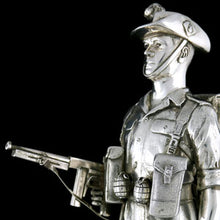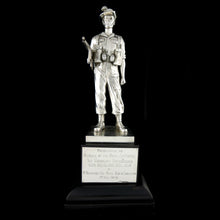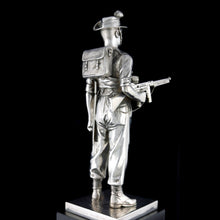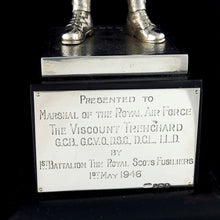Royal Scots Fusiliers - Presentation Silver Figure, 1946
- Regular price
- £8,700
- Sale price
- £8,700
- Regular price
-
- Unit price
- /per
Adding product to your cart
Height overall: 30cm (12in)
Provenance: Lord Trenchard, Marshal of the RAF and Colonel of Royal Scots Fusiliers.
Silver. Regimental presentation standing figure modelled a Royal Scots Fusilier in Jungle Green with 1944 pattern web equipment, slouch hat and hackle, armed with a Thompson sub machine-gun, two No 36 Mk I Grenades and a standard issue machete. Raised on an ebonised base applied with a silver presentation plaque inscribed 'PRESENTED TO / MARSHAL OF THE ROYAL AIR FORCE / THE VISCOUNT TRENCHARD / G.C.B., G.C.V.O., D.S.O., LL.D / BY / 1ST BATTALION THE ROYAL SCOTS FUSILIERS / 1ST MAY 1946’. Height figure: 21cm (8.2in). Maker’s mark of Goldsmiths & Silversmiths Co Ltd, 112 Regent Street, London 1946. Hallmarked London 1946.
Air Marshal Hugh 1st Viscount Trenchard (1873-1956) OM, GCB, GCVO, DSO - ‘Father of the Royal Air Force’ - began his career as a subaltern in the Royal Scots Fusiliers (RSF), being commissioned in 1893 and rising to become its Colonel from 1919 to 1946. In between he changed the course of history as the architect of modern air power, dictating the role of aerial bombing; successfully fighting economic cuts to keep the air force in existence during the interwar years; and creating a service that became accepted as the pattern of national air forces around the world. 'Without him’ it has been said thay ‘there would have been no Battle of Britain’.
Read more
As Colonel of the RSF, Trenchard visited its battalions on active service in Belgium, in the Middle East, in Normandy and Holland during the Second World War. The present figure was probably presented to mark the end of his service as Colonel of the Regiment. 1RSF was brigaded throughout the war with other regulars in the 29th Independent Brigade Group. The battalion participated in the Battle of Madagascar in 1942 as did the 2nd Battalion RSF. 1RSF then transferred to India to fight the Japanese in the South-East Asian theatre as part of the XIV (Forgotten) Army.
Trenchard’s own service began as a subaltern in India at Landi Kotal where he carried off a tent pegging prize at the Royal Scots Fusiliers gymkhana in 1899. He saw active service as a captain with the 2nd Battalion in South Africa where he was ‘dangerously wounded in the chest’ in a Boer ambush at a Highveld farm, Dwarsvlei, north of Krugersdorp, as he approached the front door. In 1903 he was seconded from the RSF for service in Nigeria, where he was tasked with boosting the flagging morale of the African rank and file of the Southern Nigerian Battalion of the Defence Force. He undertook annual arduous and hazardous expeditions into the vast and unpenetrated triangle of south-eastern Nigeria, ‘to pacify some of the most backward and savage tribes in the country’. On these forays’, ‘he substituted psychology for machine guns’, often eliciting intel from a captured local with a square meal issued from the cookhouse instead of a flogging. On approaching a defended village, he would achieve a bloodless victory by firing a star-shell, which demoralised the inhabitants and made fighting unnecessary. His initial term of service was for six months but at the Governor’s insistence he stayed for nine years until sent home to die in 1912 from the effects of the pestilential country. He was awarded the DSO in 1906.
The doctors’ prognosis notwithstanding, he recovered and within the space of a few days acquired a pilot's licence and embarked on a career which, in the next eighteen years, saw the creation of an air force steeped in his ideals and ideas that might be regarded by the two older services as an equal comrade-in-arms. By 1913 he was Assistant Commandant of the Central Flying School. In 1915, he assumed command of the Royal Flying Corps on the Western Front and developed his policies of launching persistent attacks in order to establish aerial dominance which became the standard doctrine of the RAF. By January 1918, he was appointed Britain’s first Chief of Air Staff. He resigned in April the same year and went on to organise the Inter-Allied Independent Bomber Force, a force of RAF heavy bombers that raided targets in Germany. In 1919, he became the RAF’s first Chief of Staff. In this position, he strengthened the RAF in its early years by founding colleges for air cadets and staff officers and by introducing short-service commissions that built a reserve of trained officers. He remained Chief of Staff until 1927, when he became the first Marshal of the RAF.
Retiring from service two years later, he was made a baronet (1919), a baron (1930) and a viscount (1936). He went on to serve as Commissioner of the Metropolitan Police (1931–1935) and in 1936 Chairman of the United Africa Company of which board he was an untiring member until the day of his death in 1953. He was laid to rest in the chapel of Westminster Abbey dedicated to the Royal Air Force, the service of which he was ‘the supreme architect’.












